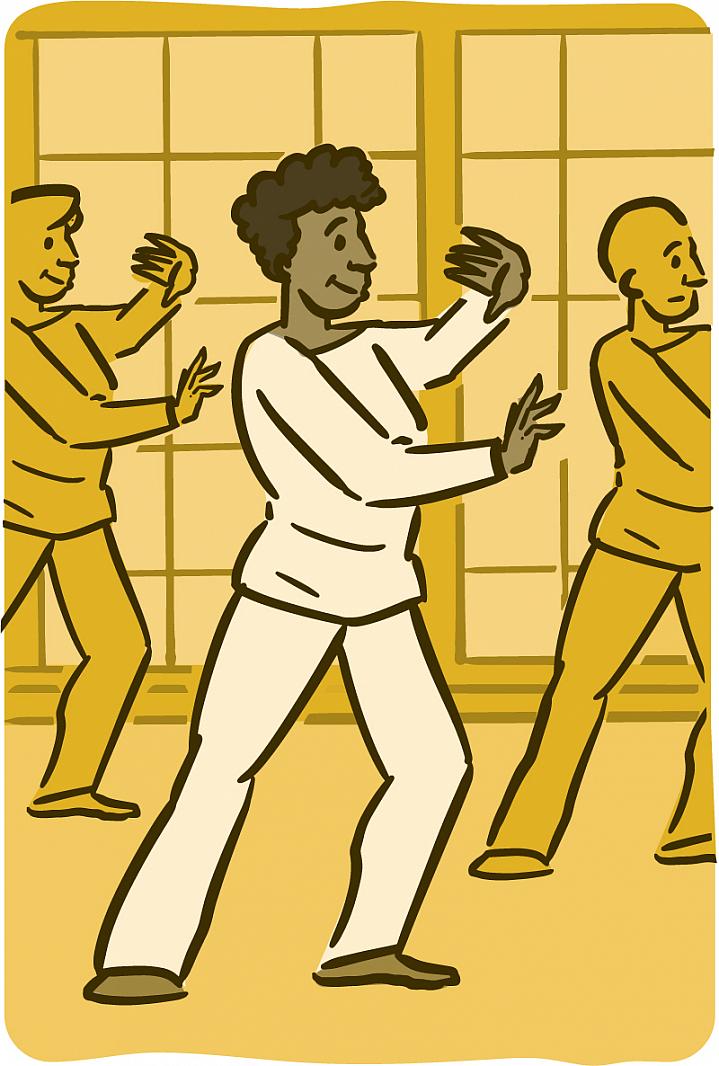Tai Chi and Your Health
A Modern Take on an Ancient Practice

You may have seen the flowing postures and gentle movements of tai chi and wondered what it’s all about. Tai chi is an ancient mind and body practice. While more research is needed, studies suggest that it may have many health benefits.
Tai chi is sometimes referred to as “moving meditation.” There are many types of tai chi. They typically combine slow movements with breathing patterns and mental focus and relaxation. Movements may be done while walking, standing, or sitting.
“At its root, tai chi is about treating the whole person and enhancing the balance and crosstalk between the body’s systems,” says Dr. Peter Wayne, a longtime tai chi researcher at Harvard Medical School. “It’s a promising intervention for preserving and improving many areas of health, especially in older adults.”
Several studies have found evidence that tai chi can increase balance and stability in older people and reduce the risk and fear of falls. Each year, more than 1 in 4 older adults falls, and 1 out of 5 of these falls causes a serious injury such as broken bones or a head injury.
“Trying to be careful can make you more prone to falls,” Wayne says. “Tai chi may help you move more confidently and safely again.” Some NIH-funded research suggests that tai chi may also improve balance and prevent falls in people with mild-to-moderate Parkinson’s disease.
Research suggests that practicing tai chi might help improve posture and confidence, how you think and manage emotions, and your quality of life. Studies have found that it may help people with fibromyalgia sleep better and cope with pain, fatigue, and depression. Regular practice may also improve quality of life and mood in people with chronic heart failure or cancer. Older adults may find that tai chi can help improve sleep quality and protect learning, memory, and other mental functions.
Further study will be needed to fully evaluate and confirm the potential benefits of tai chi. But since the practice involves moving slowly and mindfully, there’s little chance of harm when done correctly.
“Whether you’re interested in trying tai chi to help with a chronic health issue or the stresses of everyday life, tai chi—if taught properly—can be a great complement to other ways of healthy living and rehabilitation,” Wayne says. “I think we’re all looking for tools to help us live productive, long lives with a little more grace and ease.”
There are different styles and ways to practice tai chi, Wayne says. If you’re interested in trying it, you can start simply. For instance, try standing behind and holding onto a sturdy chair for support, then mindfully rock back and forth to build awareness of all the parts of your body and their connections. Eventually, you might move on to practice more complex movements or sequences.
Want to learn more? Read the Wise Choices box to consider whether tai chi might be right for you. And watch NIH’s online tai chi videos at nccih.nih.gov/video/taichidvd-full.
NIH Office of Communications and Public Liaison
Building 31, Room 5B52
Bethesda, MD 20892-2094
nihnewsinhealth@od.nih.gov
Tel: 301-451-8224
Editor: Harrison Wein, Ph.D.
Managing Editor: Tianna Hicklin, Ph.D.
Illustrator: Alan Defibaugh
Attention Editors: Reprint our articles and illustrations in your own publication. Our material is not copyrighted. Please acknowledge NIH News in Health as the source and send us a copy.
For more consumer health news and information, visit health.nih.gov.
For wellness toolkits, visit www.nih.gov/wellnesstoolkits.



